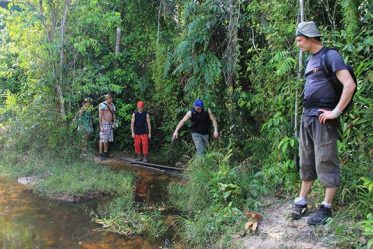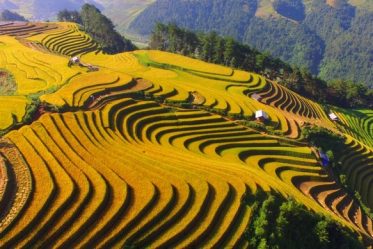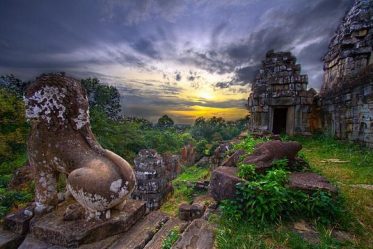Leaving its bloody history behind, Cambodia is rising as a destination for intrepid travelers who look for a place that has everything, from a sophisticated culture, hospitable locals, and pristine beaches.
Cambodia, or the Kingdom of Cambodia, is located in the Indochinese peninsula, between Vietnam (to the East), Laos (to the North), and Thailand (to the West). The country occupies 181,035 square kilometers. It also has a coastline on its Southern part of 443 km on the Gulf of Thailand.
Cambodia has a population of more than 14.7 million inhabitants divided into three major ethnic groups. The vast majority of the Cambodian population is of Khmer origin with 87% of the total population (a large number of Khmer people are Chinese or Vietnamese origin).
With 5% Vietnamese immigrants and about 3% Chinese immigrants. The rest of the population is a mix of different ethnic groups that have migrated after the troubled times of the 20th century.
Some of them are ethnic groups like the Chams, who are the only Muslims in Cambodia. And the other ethnic groups include the Brao, Kravet, and Mnong.
The weather of Cambodia reflects the region where Cambodia is located. The weather of Cambodia is somewhat similar to the weather of Southern Vietnam. It has two seasons: a dry and warm season from November to May, and a rainy – warm season from June until the end of October.
Cambodia’s history reflects the periods of peace and great calamity. From its early cities to the introduction of Hinduism and Buddhism, the great kingdom of Angkor, colonialism, and the Khmer Rouge, this essay tries to put its current rebuilding of civil society in the context of its incredible history and the challenges it faces today.
When the Communist insurgents known as the Khmer Rouge seized control of Cambodia in 1975, a spokesman claimed that in the process “2,000 years of history” had come to an end.
Under the peace agreements signed in Paris in 1991, Cambodia came under United Nations protection for a time in preparation for the general elections that were held in 1993.
Since then, Cambodia has been a constitutional monarchy ruled by a coalition government that has accepted large infusions of foreign aid. In 1999 Cambodia became a member of ASEAN. For the first time, after centuries of isolation, a full-fledged member of the Southeast Asian community.
Cambodia is predominantly Buddhist with 90% of the population being Theravada Buddhist, 1% Christian. And the majority of the remaining population follow Islam, atheism, or animism.
Buddhism has existed in Cambodia since at least the 5th century CE. Theravada Buddhism has been the Cambodian state religion since the 13th century CE (excepting the Khmer Rouge period). And it is currently estimated to be the faith of 90% of the population. Buddhism is the official religion in all of Cambodia.
Family and hierarchy within society as a whole are extremely important parts of the culture. They have great respect not only given to senior members but elderly strangers. An obvious sign of respect is the traditional Cambodian greeting, the sampan, or the pressing of the hands together while bowing.
Community life, particularly within the countryside, is very common. And families usually live in the same house or as neighbors. Clothing is a significant part of Cambodian culture, with traditional attire still commonplace.
The most well-known piece of Cambodian dress is the karma. This ingenious piece of cloth can be used for almost anything. It ranges from a towel, a child’s hammock, protection from the sun, or just simply as a fashion accessory.
Women and men still favor the sampan, a colorful material styled into a sheath, for the lower half of the body, although both sexes now usually wear typical western clothing. This type of attire is still pulled out for special occasions, especially weddings.
Home to the iconic Angkor Wat, Siem Reap is a must-see destination in Cambodia. The city today sees a huge number of tourists. It has a wide range of services dedicating the vacation. 10 minutes away from the city center is the rural countryside. This is where visitors can lay back for a few days after exploring the holy temples.
Phnom Penh is Cambodia’s capital. This bustling capital is a rising star with modernizing infrastructure. Phnom Penh is a vibrant urban hub that resembles the new Cambodia that the world wants to see. Another factor that attracts tourists to Phnom Penh is the food landscape. The cuisines here are so diverse. Travelers can treat their tummies with all kinds of food around the world.
This quaint beach town is the quiet version of Sihanoukville. It’s a nice place to relax near the ocean without the party atmosphere that is Sihanoukville.
A city near the Thai border in the Cardamom Mountain district is Koh Kong. It offers great opportunities for jungle trekking. Other than that, this is also a chance to relax on the white-sand beaches.
Though it’s the third-largest city in Cambodia, most travelers overlook Kampong Cham. The city has retained a lot of its old French colonial feel. And it is a great place to get to know Cambodia.
Most people come here to enjoy the scenic riverside views, as well as the rolling hills that surround the city. You can explore easily enough on foot or by bicycle. Kampot is a great place to slow down and relax.
The peaceful province of Kratie is in the Central region of Cambodia. This is a real heaven on Earth for those planning an eco-adventure vacation. Thanks to the swathe of rare wildlife, Kratie has become more popular in the global travel community. Numerous community-based tourism projects have been playing a big role in promoting the potential of Kratie tourism.
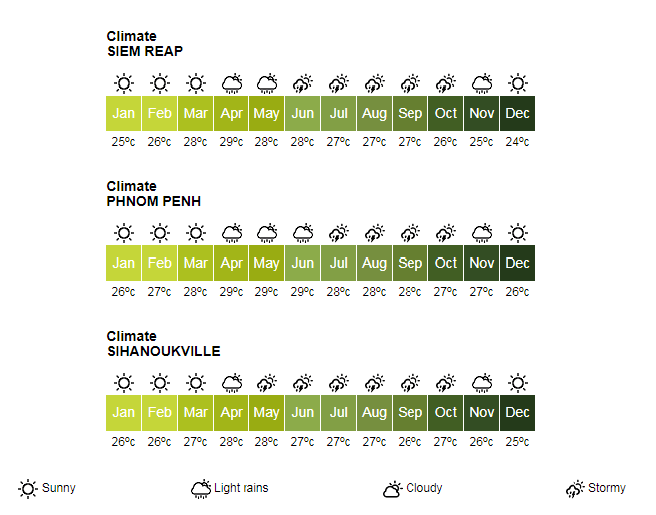 | Capital: Phnom Penh Currency: Riel (KHR) Rate: 1 USD ≈ 4,088 KHR Area: 181,035 km2 Population: 15.3 million people Language: Khmer; English & French |
For further information about Cambodia, please download our brochure Cambodia Pre-departure Information here: DOWNLOAD
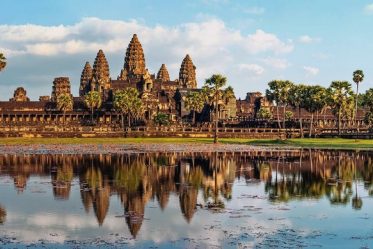
Take a lifetime journey to see the highlights of Vietnam and Cambodia and all the gems in between. Go beyond what...
